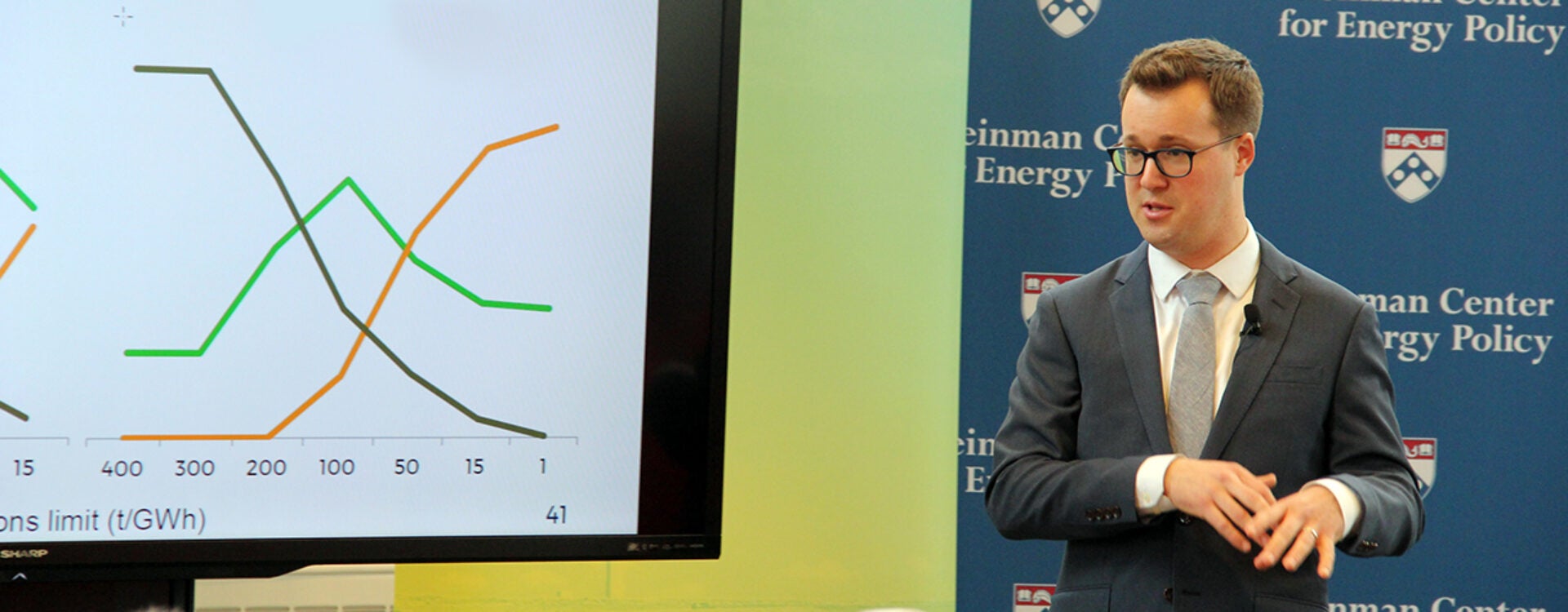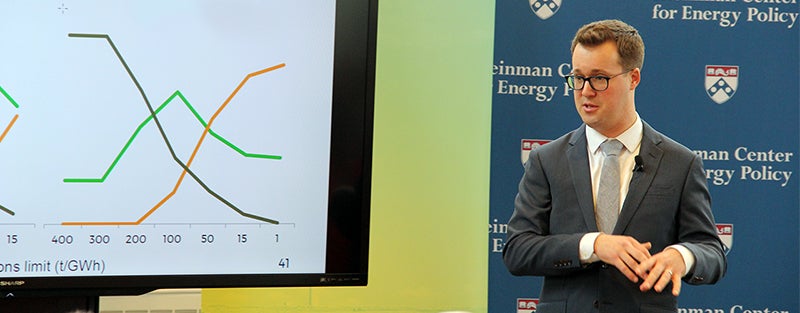
A Clean Grid is a Diverse Grid
The work of Jesse Jenkins, and his vision for the future

The electric grid has been called the largest machine ever built. Now more than a century old, it is also our single largest source of greenhouse gasses which, the United Nations warns, are destined to drive “severe, pervasive and irreversible” climate damage by midcentury if left unchecked.
Ironically, technology exists today that’s capable of slashing CO2 emissions. Society’s bigger challenge will be drumming up the political and economic will to make electric system transformation reality.
The Cheapest Path to the Cleanest Electric Grid
Recently, a visiting scholar to the Kleinman Center presented new research that identifies the least expensive paths to a carbon-free grid, in hopes of bringing such an electric system closer to reality.
Jesse Jenkins is a Ph.D. candidate and researcher with the Electric Power Systems Center at the Massachusetts Institute of Technology. In a soon-to-be-published research paper, now in peer review, Jenkins and a group of MIT engineers have modeled and priced “deeply decarbonized” electric systems that would make the global CO2 reductions both technically and economically viable.
“Electricity is the lynchpin in our efforts to decarbonize the economy,” Jenkins said in his presentation at the Kleinman Center on February 1.
In a low-carbon future, cleanly generated electricity reduces the carbon footprint of light bulbs and TVs. Critically, however, clean electricity also “helps to decarbonize transportation, heating, and industry,” says Jenkins. “Electricity demand may double as a result.”
While modeling future low-carbon electric grids isn’t new, Jenkins and his MIT colleagues’ research stands out for its use of a detailed model that includes not only investments but also detailed engineering constraints that mimic how power systems operate. They also account for a wide range of uncertain assumptions about technology cost, availability and CO2 emissions limits.
Envisioning 2050
They modeled a range of electricity systems for the year 2050, including moderately decarbonized grids with emissions intensity that would be 60% to 80% below that of the U.S. grid today. Deeply decarbonized electricity systems, with emissions of 50 metric tons of CO2 per gigawatt-hour of electricity produced, would cut carbon by 90% or more.
A moderately decarbonized grid will look very much like proponents of renewables might expect. Increasingly cheap wind and solar power will scale up. Natural gas, battery storage and demand response, which cuts air conditioning and lighting use on hot summer days, will help to balance demand for electricity against renewable resources that aren’t always available (such as solar on a cloudy day).
But a deeply decarbonized grid will look very different.
Nuclear Power Plays Key Role
“In a 99% carbon-free electricity system the shares of wind and solar power decline, and nuclear or other low-carbon ‘flexible base’ resources dominate and totally displace natural gas,” Jenkins said.
The nuclear power plants would be of the “variable” type currently operated in France, Germany, and Switzerland, which can raise or lower output in response to changing electricity demand.
Other flexible low-carbon resources could include geothermal and hydropower dams with large reservoirs. Gas and coal would only survive if paired with carbon capture and storage, which has yet to be proven economical.
Critically, the use of flexible base resources would allow the total amount of electricity generating capacity to be “right sized” to demand. In contrast, a grid dependent on renewables would have to be multiples larger, and more expensive, than a diverse grid. It would require a huge oversupply wind turbines and solar farms to eke out enough electricity to meet demand on days with little wind and/or sun.
Jenkins summed up the issue with a basketball analogy. “A zero-carbon grid made only of renewables would be like a basketball team made only of point guards. The game’s difficult as it is, no reason to make it harder on ourselves.”
Yet, given nuclear’s high cost, it seems unlikely that even a right-sized grid with 50% or more of nuclear in the mix could be “lowest-cost.” In Jenkin’s defense, not once did he utter the word “cheap” during his presentation at the Kleinman Center.
From Computer Science to Energy
Jenkins’ ability to articulate in everyday language the complexities of the electricity system have helped to get word of his research, and expertise, out beyond the lab. He has yet to complete his Ph.D.-he plans to finish up this spring. Yet he has consistently been one of the most widely quoted energy experts in the U.S. over the past few years, with his interviews and writings appearing in the New York Times, the Wall Street Journal, and on NPR.
Yet energy wasn’t even on his radar when he started out as an undergraduate computer science and philosophy major at the University of Oregon. As an honors student, Jenkins enrolled in an upper level colloquium on the environmental impact of energy systems. His teacher, former astrophysicist turned energy professor Gregory Bothun, “opened my eyes to important societal changes related to energy that would remain important over my lifetime.”
After graduating, Jenkins started a blog that mapped his own energy learning. He landed a job in renewable energy advocacy with Renewable Northwest in Portland, and helped develop, negotiate and pass Oregon’s Renewable Energy Act of 2007, which established the state’s requirement that utilities purchase 25% of their electricity from renewable resources by 2025. Next, he was hired to run the summer fellows program at the Breakthrough Institute, where he eventually spent four years, leading research into energy, climate change, and innovation policy.
From there he returned to school and earned a master’s in Technology and Policy before enrolling in the Ph.D. program in engineering systems at MIT.
“I returned to school to get the tools for quantitative analysis to answer these energy questions,” he says. “Before I was in a synthesis role, and I wanted to be in a position to research and develop answers to the questions myself.”
Rethinking Renewables
“Climate change is one of many priorities, and there’s limited willingness among the public to pay for decarbonization,” Jenkins freely admits. His ask of policymakers? “Don’t set a 100% renewable energy requirement or lock us in to a specific path to cut CO2. Instead, set 100% decarbonization as the goal. Invest in technologies needed for each of the key roles in the power system. Keep our options open.”
Jesse Jenkins talks about deep decarbonization in the latest episode of the Kleinman Center’s Energy Policy Now podcast, also on iTunes.
